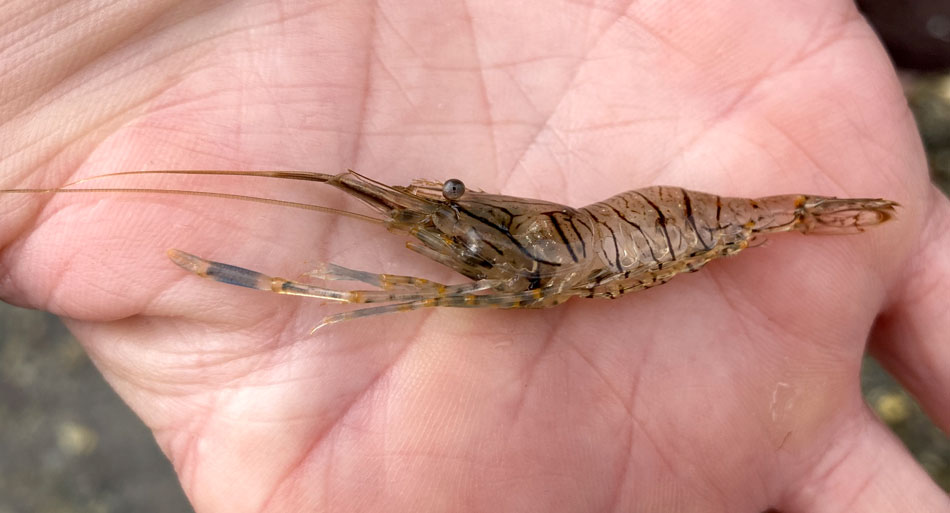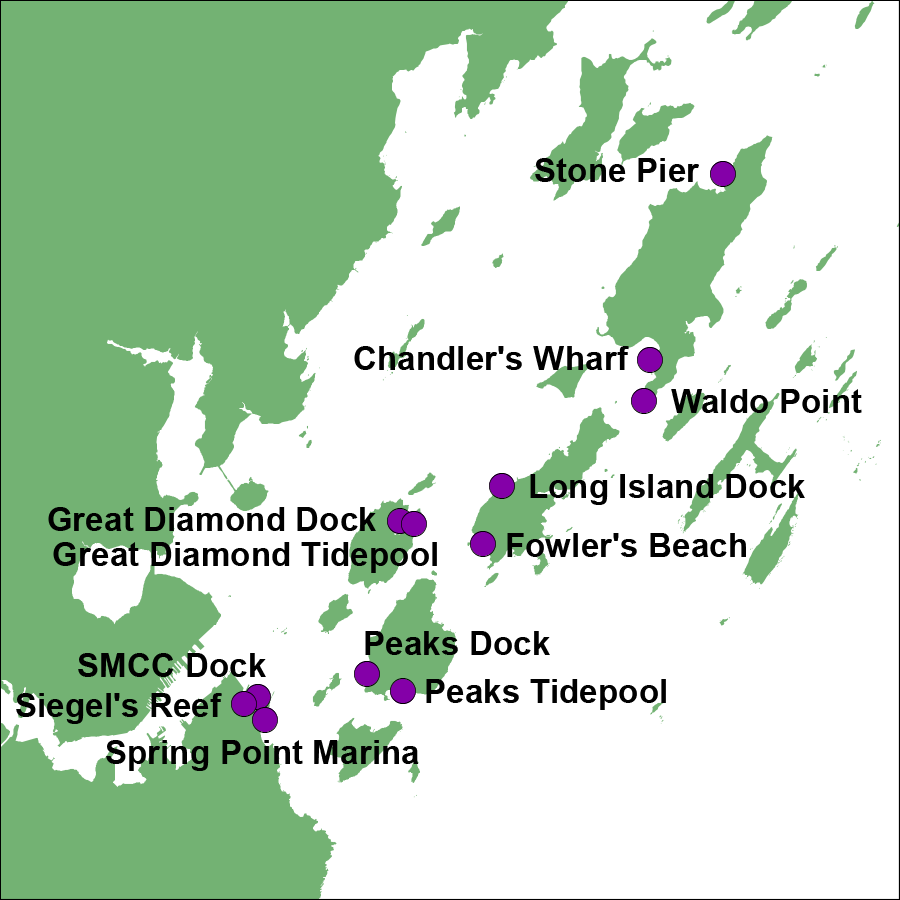Invasive Species Persist in a Warming Casco Bay
Tunicates Are Especially Abundant and May Displace Other Species
WHY IT MATTERS
Invasive species are animals, algae, and other organisms that are not native to a region but arrive there through human activity and become self-sustaining. They may harm ecosystem processes, the economy, and public health.
The highly invasive European green crab, Carcinus maenas, was first observed in Casco Bay in 1905. It has become the dominant species of shore crab along the Maine coast, preying on soft-shell clams, uprooting eelgrass, and causing erosion in tidal marshes.
But other invasives are less noticeable. For example, small colonial tunicates and bryozoans grow abundantly as part of the “fouling communities” of organisms found on hard surfaces such as rocks, pilings, docks, and floats. While native species remain, many of the most abundant, colorful, and visible species are non-native arrivals. Some invasives grow on blades of eelgrass and kelp, impairing their growth.
Invasive species are often indicators of changing marine ecosystems. While many of the most harmful ones are native to Europe or Asia, other species turning up in our waters are from closer to home and are properly termed “range-shifters”. For example, mid-Atlantic species such as the fiddler crab are expanding their ranges and may displace native species.

Invasive species are often indicators of changing marine ecosystems. While many of the most harmful ones are native to Europe or Asia, other species turning up in our waters are from closer to home and are properly termed “range-shifters”. For example, mid-Atlantic species such as the fiddler crab are expanding their ranges and may displace native species.
STATUS & TRENDS
The Marine Invader Monitoring and Information Collaborative (MIMIC) in Casco Bay is a partnership between CBEP and the Wells National Estuarine Research Reserve (Wells NERR). Wells NERR trains community scientists to identify 23 species of invasives, including tunicates, bryozoans, algae, and crustaceans.
MIMIC Sampling Sites
Community scientists visit floating docks at piers or marinas, and tidepools each month between May and October and document presence (and approximate abundance) of these species. The program began with two sites in Casco Bay in 2008 and has expanded to include twelve mainland and island locations (see map). Sampling on the islands began in 2014, when four volunteers sampled just two sites. In 2020, twenty-one volunteers sampled nine sites on four islands.
Among the most abundant non-native species are colonial or solitary tunicates (pictured at top of page), which are found more frequently on docks than in tidepools. Two species— Didemnum vexillum (present in Maine since approximately 1978) and Diplosoma listerianum (a recent arrival)—can grow over many other species and may become dominant at some sites.
Increase in Monitoring 2008 to 2020
Number of Observations by Major Taxon
Average Invasive per Site Visit & Total Invasives Observed at Sites
Percentage of Observations by Major Taxon
Colonial Tunicate Now Firmly Established
Rapid Assessment Survey (RAS)
The Gulf of Maine Rapid Assessment Survey (RAS) is a regional survey of invasive species conducted every three to five years and led by the Massachusetts Office of Coastal Zone Management and MIT Sea Grant College Program. Since 2000, scientists have sampled dozens of sites from Maine to New York in July or August. Taxonomic experts identify native and non-native macroalgae and invertebrates on floating docks and related structures, such as pilings, ropes, and boat fenders.
From Massachusetts to Maine, the teams found that the percentage of invasive species has remained relatively stable, with less than a quarter of all species observed in both 2013 and 2018 known to be invasive.
Several species, however, have expanded their range. For example, the colonial tunicate Didemnum vexillum and the bryozoan Tricellaria inopinata were observed more frequently in Maine, and the ranges for the algae Colpomenia peregrina (moving southward) and Grateloupia turuturu (moving northward) expanded. Dasysiphonia japonica, a red alga, was observed for the first time in 2018 at both sites surveyed in Casco Bay—Port Harbor Marine (Portland) and Brewer South Freeport Marine (South Freeport)—continuing its northward expansion. At Casco Bay sites, the total number of species declined from 2013 to 2018, and more cryptogenic species were observed.
Species at Two RAS Sites in Casco Bay
successes & challenges
- The MIMIC program provides an “early detection system” for marine invaders in Casco Bay. MIMIC provides a network of organizations and trained volunteers to track marine invaders on the mainland and now on the islands. The data collected by MIMIC are shared with state agencies and others to provide insights into what species are present and alerts for new arrivals.
- Controlling or managing invasive species in the marine environment is difficult because of their diversity and complex life histories. Because few strategies exist for restricting the spread of invasive species once they become established, education to prevent new arrivals is paramount.
- Continued monitoring and collaborative efforts with local coastal stakeholders continue to be our best approach to understanding and mitigating the effects of these invaders. There are actions taking place to mitigate impacts from, and finding uses for, some of these species. For example, the Wells NERR and others are working with local fishermen in southern Maine to improve the market for green crabs.
View a PDF version of this page that can be downloaded and printed.
View references, further reading, and a summary of methods and data sources.
STATE OF CASCO BAY
Drivers & Stressors
What’s Affecting the Bay?
Human Connections
What’s Being Done?
If you would like to receive a printed State of Casco Bay report, send an email request to cbep@maine.edu.
This document has been funded by the U.S. Environmental Protection Agency under Cooperative Agreements #CE00A00348-0 and #CE00A00662-0 with the University of Southern Maine.
Suggested citation: Casco Bay Estuary Partnership. State of Casco Bay, 6th Edition (2021).
